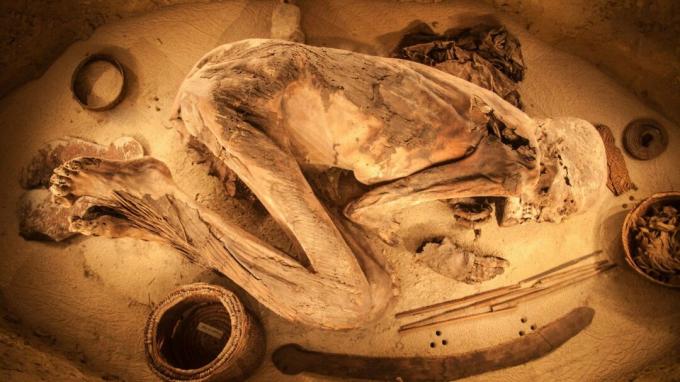The 6 strangest (and most curious) medical remedies in history
Unicorn horn, aspirations of mercury, healings of kings... The history of humanity is full of very curious anecdotes in the field of medicine. To us, human beings of the 21st century, they may seem quite strange remedies and, without a doubt, some will make us smile or, on the contrary, make us wrinkle our brows in disgust. But the reality is that many of them were used without problem for centuries, and even millennia.
- We recommend you read: "Why did the Egyptians mummify the dead?"
The strangest remedies in history
Below, we explain what 6 of the strangest remedies in history consisted of. Get ready for a completely surprising journey.
1. If you have syphilis… breathe in mercury
Syphilis is a venereal disease that, as such, is transmitted mainly through sexual intercourse., although it can also be passed from mothers to children. During the first decades of the 16th century it suffered an unusual virulence in Europe, so doctors began to worry about finding a treatment to eradicate it.
The symptoms of syphilis could last for years, and even a lifetime, in which episodes of remission alternated with a virulent return of symptoms. These could be really painful and, in their most serious stages, cause paralysis and, of course, death. One of the clearest manifestations was the red buboes that appeared on the skin, for which mercury ointments began to be used.
But probably the most popular therapy for “Venus disease” was “sweat tubs.” These were cabins with stoves where the infected person was placed, who was forced to inhale the vapor impregnated with mercury. Of course, the harmful effects of mercury were greater than the supposed cure: the patients They suffered from acute headaches, tooth loss, paralysis and convulsions, due to the poisoning. Some died directly. Mercury therapy (whether cutaneously or through pills and tablets) was continued until well into the 20th century, when the discovery of penicillin made it possible to treat syphilis properly.
2. Leeches and bloodletting
Believe it or not, bloodletting was practiced until the beginning of the 19th century. At first, leeches were used, but later incisions were made in the patient's arm, from which quantities of blood were extracted and then discarded. The objective of this curious procedure was to “extract” the harmful fluid that ran through the patient's blood.
The bloodletting remedy obeyed the theory of humors, in force since classical antiquity, due to the It was believed that the disease was the product of an imbalance between the four basic humors of the body. body. These humors were phlegm, black bile, yellow bile and, of course, blood. The latter was considered the key to the active state of the body, so a “sanguine” person was a vital and joyful person.
In addition to the imbalance of these humors, the disease could also be caused by their corruption, that is, by the introduction of certain “vapors” that poisoned the fluids. In this case, it was vitally important to extract these substances that were harming the functioning of the body. Bleeding was, therefore, one of the methods by which it was believed that blood “vapours” were expelled from the body.
As is evident, This procedure only weakened the patient.. However, there are specific cases in which a significant improvement was noted; These were probably hypertension symptoms, which were relieved by reducing blood flow pressure.

3. Madness is a stone and it is in the head
One of the most famous images of the “stone of madness” is the panel by the painter Hyeronimus Bosch (Hieronymus Bosch) that shows a strange character, dressed in a strange hat that looks like a funnel, in the act of trepanning the patient; that is, to open his skull.
During ancient times, authors such as Herophilus of Chalcedon (335-280 BC. C.) and the distinguished physician Galen (129-216 AD. C.) claimed that reasoning was found in the ventricles of the brain. These theories were taken up in medieval times, and “madness” was considered the manifestation of pressure on brain tissues due to strange mineral formations. Hence the idea of the “stone of madness”, the one responsible for causing strange behaviors in human beings, and the need to extract it..
But cranial trepanation has been a constant in the history of humanity. The oldest vestiges of this type of surgery date back to the 6th millennium BC. C., although scholars still doubt whether these are rituals or real medical “cures,” perhaps to relieve migraines and cure mental illnesses. The most curious thing about the case is that, in some cases, and judging by the remains found, the people subjected to trepanation survived the operation for a few years. Of course, what we do not know is whether the discomfort that had led them to undergo surgery subsided or, on the contrary, persisted.
4. Mummy powder, remedy for everything
Can you imagine swallowing pulverized remains of a mummy? Well, the Europeans of the 16th and 17th centuries seemed not to care. Not only that; Beginning in the final centuries of the Middle Ages, the consumption of mummy powder to cure all types of diseases became so fashionable that it unleashed a real fever to dig up corpses mummified
The most curious thing is that this story is the result of a confusion. Because travelers visiting Egypt had confused Persian mummia (literally, “bitumen”) with embalmed bodies. Mummy was a mineral derived from tar that reportedly had the ability to increase scarring and healing of broken bones; The Persians used it on the battlefields to treat their soldiers' fractures.
When word spread that “mummies” possessed such properties, the corpses began to be ground up and sent to apothecaries in Europe.. In reality, the problem came from the substances that coated the bodies, similar in appearance to Persian bitumen. The most serious thing was that, given the high demand, traffickers began to sell “recent” corpses, which they passed off as by Egyptian mummies, and which the enthusiastic Europeans also swallowed, without the slightest hint of disgust or worry.

5. The best doctor, the king
“The king touches you, God heals you.” This was one of the formulas that had already become very popular in the 16th century to celebrate the “royal touch”, that is, the laying on of the king's hands on a patient affected by scrofula.. The custom probably dates back to Carolingian times, and gained great momentum during the 12th and 13th centuries.
It was assumed that the French or English monarch (it seems that this curious custom was common in both kingdoms, although it is not known where he appeared before), while anointed by God, he had thaumaturgic power; that is, he could cure his subjects. It was not about equating the monarch with Christ and his miraculous power, but rather, the king represented a vehicle, a bridge that connected the sick person with the power of God.
The usual illness that kings “cured” was scrofula, also known as “the king's illness.” It is a bacterial infection that inflames the lymph nodes in the neck and is generally not fatal, so cure rates They were quite high, a factor that would undoubtedly help fuel the belief that the monarch had removed the illness from his faithful subject.
6. The highly sought after unicorn horn
Impotence or sexual inappetence has been an obsession for men for millennia.. As such, since ancient times there have been a wide variety of remedies to encourage the pleasures of Venus; we can cite countless delicacies that, supposedly, fueled the masculine fire: rooster combs and testicles, plums cooked, and even the humble lettuce were considered sexual enhancers, depending on the fashion and customs of each era.
But probably the most popular (and most sought after) ingredient was unicorn horn. To begin with, we have a problem: unicorns do not exist, so, a priori, it is frankly difficult to get one of their horns. But this is where the inventive capacity of human beings comes into play, especially when it comes to doing business.
The historian Laia San José proposes, in the program The Fluzo Condenser (TVE) two possible solutions to the “mystery” of the large amount of unicorn horn dust that arrived in Europe during the Middle Ages, due to the high demand for this product to cure loss of appetite or impotence sexual. On the one hand, it could be that this powder was made with rhinoceros horn, an animal with little or no known on the European continent but which, however, was highly appreciated in Asia for its qualities healing. On the other hand, San José proposes a second option, which is none other than the Vikings themselves who, supposedly, would have trafficked in walrus and, later, narwhal horns. Desperation believes everything, it seems.

